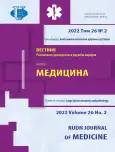Первый опыт лазерной литотрипсии при сиалолитиазе
- Авторы: Жучкова Д.В.1, Сысолятин С.П.1,2, Банникова К.А.2
-
Учреждения:
- Российский университет дружбы народов
- Клиника «Эндостом»
- Выпуск: Том 26, № 2 (2022): АНАТОМИЯ И ПАТОЛОГИИ КРУПНЫХ СУСТАВОВ
- Страницы: 170-179
- Раздел: Дантистика
- URL: https://journal-vniispk.ru/2313-0245/article/view/319639
- DOI: https://doi.org/10.22363/2313-0245-2022-26-2-170-179
- ID: 319639
Цитировать
Полный текст
Аннотация
Актуальность . Современные пределы эндоскопического удаления сиалолитов ограничены 3-5мм, более крупные сиалолиты требуют дробления, но эффективная и безопасная технология пока не найдена. Решение этой проблемы в первую очередь связано с технологиями ударно-в олновой литотрипсии. В настоящее время в литературе описаны различные методы литотрипсии с применением экстракорпоральных и интракорпоральных источников. Положительный опыт урологической лазерной литотрипсии послужил основанием для нашего исследования возможностей использования тулиевого лазерного аппарата FiberLase U2 в целях фрагментации сиалолитов. Материалы и методы. В исследование включены 16 клинических наблюдений пациентов с диагнозом сиалолитиаз, которым была проведена сиалоэндоскопия с дополнительным применением методики внутрипротокового дробления конкремента тулиевым лазерным аппаратом FiberLase U2 с последующей экстракцией фрагментов. Результаты и обсуждение . Сиалолиты удалось фрагментировать во всех 16 клинических наблюдениях независимо от формы и структуры. Крупные фрагменты удалялись с помощью корзиночных ловушек и эндоскопических щипцов. В 9 из 16 наблюдений операция заканчивалась полным удалением камня и всех его видимых фрагментов (до полного очищения протока). У 7 пациентов в протоке оставались фрагменты, удалить которые не представлялось возможным. В процессе дробления мы наблюдали нежелательный эффект ретроградной мирграции камня при импульсном ударе, а также образующуюся взвесь из мелких фрагментов и пузырьков воздуха осложняли видимость и процесс операции. Также, в 3 случаях при разрушении камня луч лазера попадал на стенку протока, что сопровождалось слабым кровотечением и на время затрудняло эндоскопическую видимость и требовало активной ирригации. Выводы . Впервые применена технология литотрипсии тулиевым лазером, что позволило добиться разрушения сиалолитов и удалить камни размером более 5 мм. Данный подход расширяет пределы эндоскопической хирургии сиалолитиаза. Вместе с тем имеется ряд важных проблем, требующих дальнейшего изучения и совершенствования метода.
Ключевые слова
Об авторах
Д. В. Жучкова
Российский университет дружбы народов
Email: DaLitvinova@mail.ru
ORCID iD: 0000-0002-9200-4257
Москва, Российская Федерация
С. П. Сысолятин
Российский университет дружбы народов; Клиника «Эндостом»
Email: DaLitvinova@mail.ru
ORCID iD: 0000-0002-5794-9087
Москва, Российская Федерация
К. А. Банникова
Клиника «Эндостом»
Автор, ответственный за переписку.
Email: DaLitvinova@mail.ru
ORCID iD: 0000-0002-2501-4017
Москва, Российская Федерация
Список литературы
- Guenzel T, Hoch S, Heinze N, Wilhelm T, Gueldner C, Franzen A, Coordes A, Lieder A, Wiegand S. Sialendoscopy plus laser lithotripsy in sialolithiasis of the submandibular gland in 64 patients: a simple and safe procedure. Auris Nasus Larynx. 2019;46(5):797—802. doi: https://doi.org/10.1016/j.anl.2019.01.009
- Koch M, Hung SH, Su CH, Lee KS, Iro H, Mantsopoulos K. Intraductal lithotripsy in sialolithiasis with two different Ho: YAG lasers: Presetting parameters, effectiveness, success rates. Eur. Rev. Med. Pharm. Sci. 2019;23:5548—5557. doi: https://doi.org/10.26355/eurrev_201907_18288
- Matsunobu T, Kurioka T, Miyagawa Y, Araki K, Tamura A, Niwa K, Shiotani A. Minimally invasive surgery of sialolithiasis using sialendoscopy. Auris Nasus Larynx. 2014;41(6): 528—531. doi: https:// doi.org/10.1016/j.anl.2014.05.009
- Schrötzlmair F, Müller M, Pongratz T, Eder M, Johnson T, Vogeser M, Sroka R. Laser lithotripsy of salivary stones: Correlation with physical and radiological parameters. Lasers in surgery and medicine. 2015;47(4):342—349 doi: https://doi.org/10.1002/lsm.22333
- Yaremenko АI, Matina VN, Serova АYA, Vladimirova LG. Sialoendoscopy is a modern method of diagnosis and treatment of diseases of the salivary glands. Institute of Dentistry. 2015;1:65—65. (In Russian).
- Marchal F, Dulguerov P. Sialolithiasis management: the state of the art. Arch. Otolaryngol. Head Neck Surg. 2003;129(9):951—956. doi: 10.1001/archotol.129.9.951
- Marchal F, Dulguerov P, Becker M, Barki G, Disant F, Lehmann W. Specificity of parotid sialendoscopy. Laryngoscope. 2001;111:264—271. doi: https://doi.org/10.1097/00005537-200102000- 00015
- Sysolyatin SP, Bannikova KA, Sysolyatin PG, Gaitova VG, Baidik OD. Endo-sialoscopic diagnosis and treatment of sialolithiasis. Siberian Scientific Medical Journal. 2020;40(1):45—52. doi: 10.15372/SSMJ20200106. (In Russian).
- Sysolyatin SP, Bannikova KA, Sysolyatin PG, Ivanov SYu. Possibilities of the endoscopic method in the treatment of patients with salivary stone disease. Dentistry. 2019;98(3):60—64. doi: 10.17116/stomat20199803160. (In Russian).
- Capaccio P, Torretta S, Pignataro L. Extracorporeal lithotripsy techniques for salivary stones. Otolaryngologic Clinics of North America. 2009;42(6):1139—1159. doi: https://doi.org/10.1016/j. otc.2009.08.003
- Martov AG, Diamant VM, Borisik AV, Andronov AS. Comparative study of the effectiveness of electric pulse and laser lithotripters in vitro. Urology. 2013;2:70—78. (In Russian).
- Zenk J, Koch M, Iro H. Extracorporeal and intracorporeal lithotripsy of salivary gland stones: basic investigations. Otolaryngologic Clinics of North America. 2009;42(6):1115—1137. doi: https://doi.org/10.1016/j.otc.2009.08.005
- ChiesaEstomba CM, Saga-G utierrez C, CalvoHenriquez C, Lechien JR, Cartier C, MayoYanez M. Laser-assisted lithotripsy with sialendoscopy: systematic review of YO-IFOS head and neck study group. Ear, Nose & Throat Journal. 2021;100:42—50. doi: https:// doi.org/10.1177/0145561320926281
- Deenadayal DS, Bommakanti DNB, Naveen KM. SialolithiasisManagement with Laser, Lithotripsy. J. Dent Oral. Biol. 2019;4(1):1154.
- Martov AG, Baranov AV, Biktimirov RG, Alpin DM, Biktimirov TR. The use of laser radiation in urology. Laser medicine. 2020;24(1):57—62. doi: https://doi.org/10.37895/2071-8004-202024-1-57-62. (In Russian).
- Martov AG, Ergakov DV, Guseinov MA, Andronov AS, Dutov SV, Vinnichenko VA, Kovalenko AA. Initial experience of clinical application of thulium contact lithotripsy in transurethral treatment of urolithiasis. Urology. 2018;1:112—120. doi: 10.18565/urology.2018.1.112-120. (In Russian).
- Zolotukhin SYu, Epifanov SA. Complex treatment of patients with sialolithiasis. Bulletin of the National Medical and Surgical Center named after NO Pirogov. 2020;15(3,2). doi: 10.25881/ BPNMSC.2020.75.15.025. (In Russian).
- Kopeć T, Szyfter W, Wierzbicka M. Sialoendoscopy and combined approach for the management of salivary gland stones. European Archives of OtoRhinoLaryngology. 2013;270(1):219—223. doi: https://doi.org/10.1007/s00405-012-2145-x
- Bannikova KA, Bosykh YY, Gaitova VG, Sysolyatin PG, Sysolyatin SP. Indications for the use of the endosialoscopy method for sialolithiasis. Modern technologies in medicine. 2020;2(3):41—46. doi: 10.17691/stm2020.12.3.05. (In Russian).
- Afanasyev VV, Abdusalamov MR, Kurbanov SM. Sialoendoscopy. A new method of diagnosis and treatment of patients with salivary stone disease. Boundaries of the need for use. Dentistry. 2018;97(4):28—30. doi: 10.17116/stomat20189704128. (In Russian).
Дополнительные файлы









